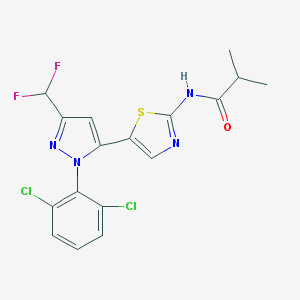| Cas No.: | 1338247-35-0 |
| Chemical Name: | N-[5-[2-(2,6-dichlorophenyl)-5-(difluoromethyl)pyrazol-3-yl]-1,3-thiazol-2-yl]-2-methylpropanamide |
| Synonyms: | BMS 5;BMS5 |
| SMILES: | CC(C)C(NC1=NC=C(C2=CC(C(F)F)=NN2C3=C(Cl)C=CC=C3Cl)S1)=O |
| Formula: | C17H14Cl2F2N4Os |
| M.Wt: | 431.287 |
| Description: | BMS-5 is a potent LIMK inhibitor with IC50s of 7 nM and 8 nM for LIMK1 and LIMK2, respectively. |
| In Vivo: | BMS-5 (20 or 200 μM/side) is bilaterally infused into the hippocampus of rats immediately after contextual fear conditioning training. Rats are tested for memory consolidation 48 h after fear conditioning. Post hoc analysis shows that the group treated with 200 μM BMS-5 express lower freezing levels compared to the 20 μM and vehicle groups (P<0.01)[3]. |
| In Vitro: | BMS-5 inhibits cofilin-Ser3 phosphorylation in a dose-dependent manner in Nf2ΔEx2 mouse Schwann cells (MSCs) with an IC50 of ~2 µM. BMS-5 reduces Nf2ΔEx2 MSC viability in a dose-dependent manner with an IC50 of 3.9 µM, but does not significantly reduce the viability of control Nf2flox2/flox2 MSCs at equivalent BMS-5 concentrations. At 10 µM BMS-5, Nf2ΔEx2 MSC viability is 40% compared to 83% for controls[2]. |






















